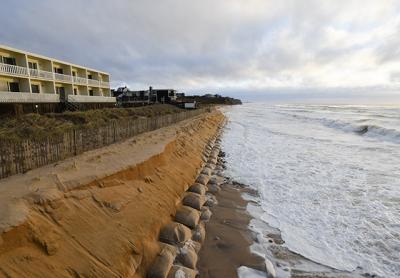Hearing Ahead on Montauk Hamlet Study

The last of five public hearings for the Town of East Hampton’s hamlet studies will happen at the town board’s meeting next Thursday and will focus on Montauk. The meeting will be held at 6:30 p.m. in the meeting room at Town Hall.
The Montauk study has looked at the hamlet’s downtown, harbor, and Long Island Rail Road station areas. Downtown, sea level rise means that the oceanfront motels vital to the local economy are increasingly vulnerable to flooding and damage from storms, while higher ground is more lightly developed. Recommendations include coastal retreat and a gradual shift from the former to the latter area.
The consultants, Peter Flinker of Dodson and Flinker, a Massachusetts consulting firm, and Lisa Liquori of Fine Arts and Sciences, a former town planning director, recommend addressing a critical shortage of affordable workforce housing through infill and second-story residential development downtown. Such development could also provide for businesses that relocate from lower-lying areas. The downtown area suffers from heavy traffic in the summer, and could be improved by connecting sidewalks and adding more crosswalks and street lighting. Wastewater management is essential, the consultants say, recommending a centralized wastewater treatment system.
Wastewater and stormwater runoff must also be addressed at the harbor, the consultants say, to improve water quality and marine habitat, and the area must be made resilient to reduce risks from sea level rise and extreme weather.
Resilience is also a buzzword in the area around the train station, near Fort Pond Bay. The study also recommends creation of a transit hub there, as well as the addition of mixed-use buildings.
In previous public hearings, the hamlet studies have drawn mixed reviews. The hearing on the Wainscott study, held on Oct. 4, was mostly positive, its residents seeing opportunities to alleviate traffic congestion and the critical shortage of affordable housing, connect parking lots and pedestrian and bicycle pathways, reduce nitrogen and phosphorus inputs to Georgica Pond, and reduce the strip-mall look and feel of its commercial core in favor of walkable, connected outdoor public spaces.
By contrast, the East Hampton study was criticized at its Oct. 18 hearing, largely by residents of Springs who predicted further stress on the already crowded corridors connecting East Hampton with their hamlet, chiefly Springs-Fireplace Road.
Public comment at the Nov. 1 public hearing for the Amagansett hamlet study was varied. While residents agreed with many of the consultants’ recommendations, other suggestions were received coolly, with several speakers telling the board that they like Amagansett just the way it is. At the Nov. 15 public hearing on the Springs study, worries about future development of the aforementioned commercial area just beyond the border, specifically the Springs-Fireplace Road corridor between North Main Street and Abraham’s Path, dominated the discussion.
The goal of the studies is to adopt recommendations for each hamlet that can be incorporated into the town’s comprehensive plan.
